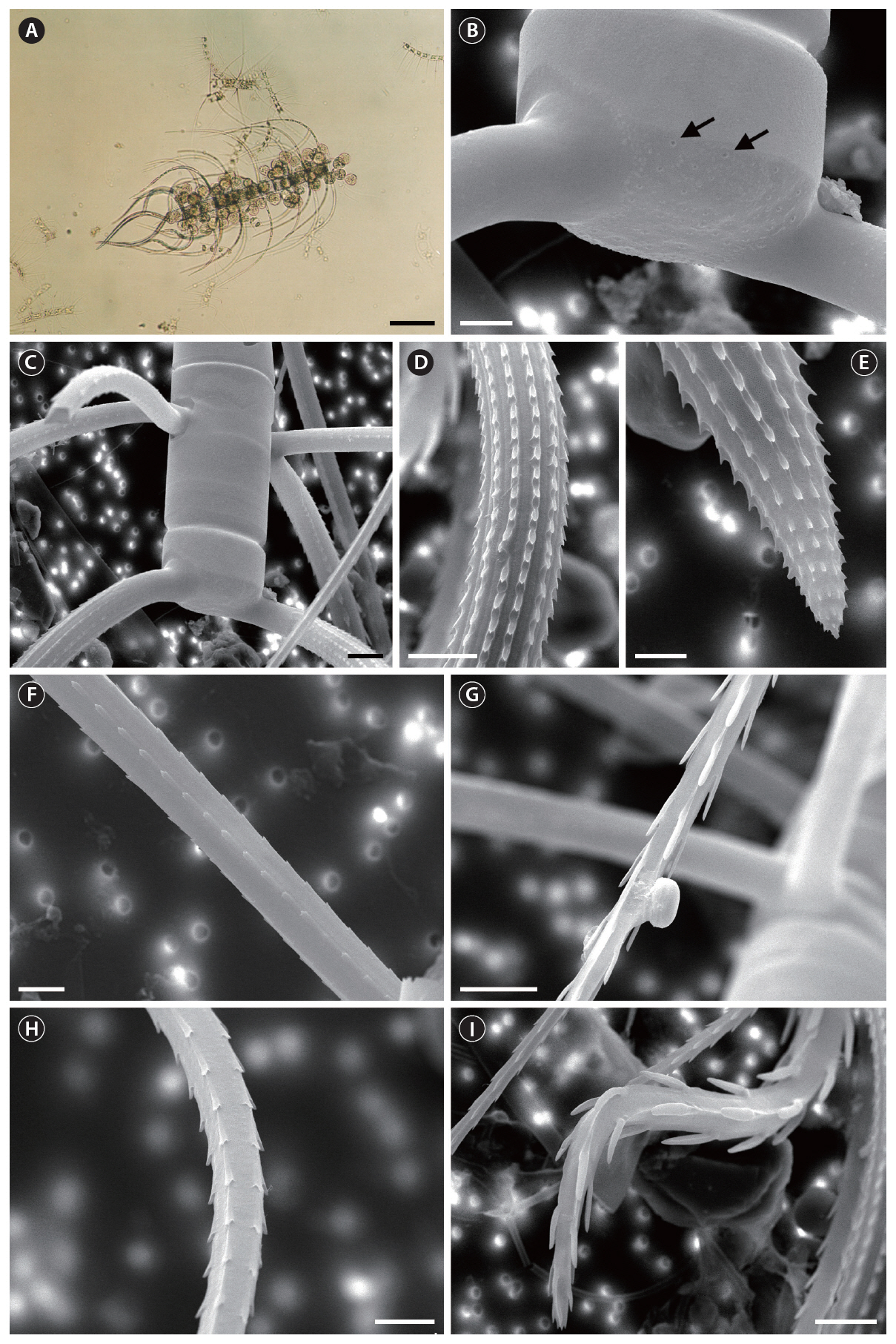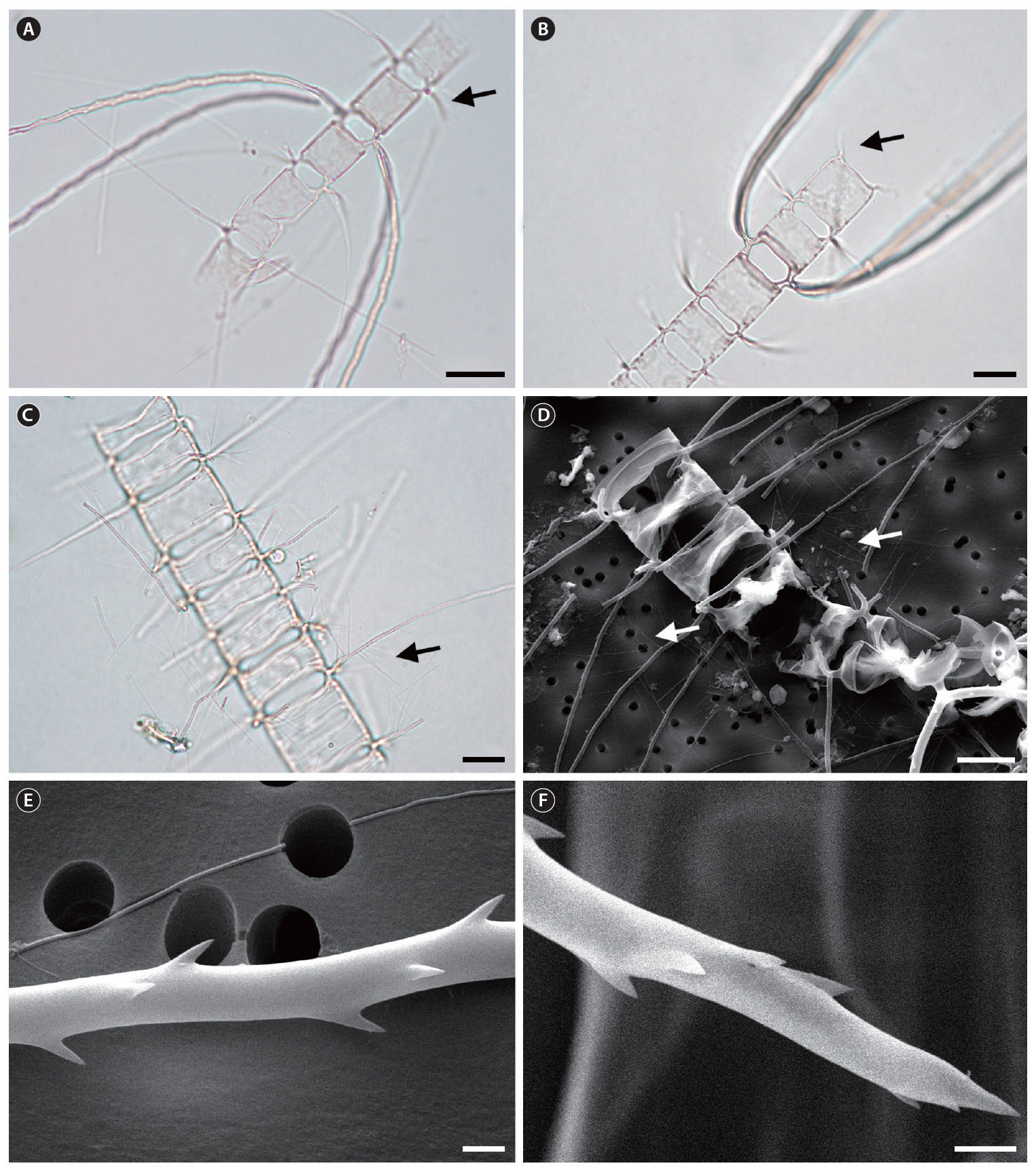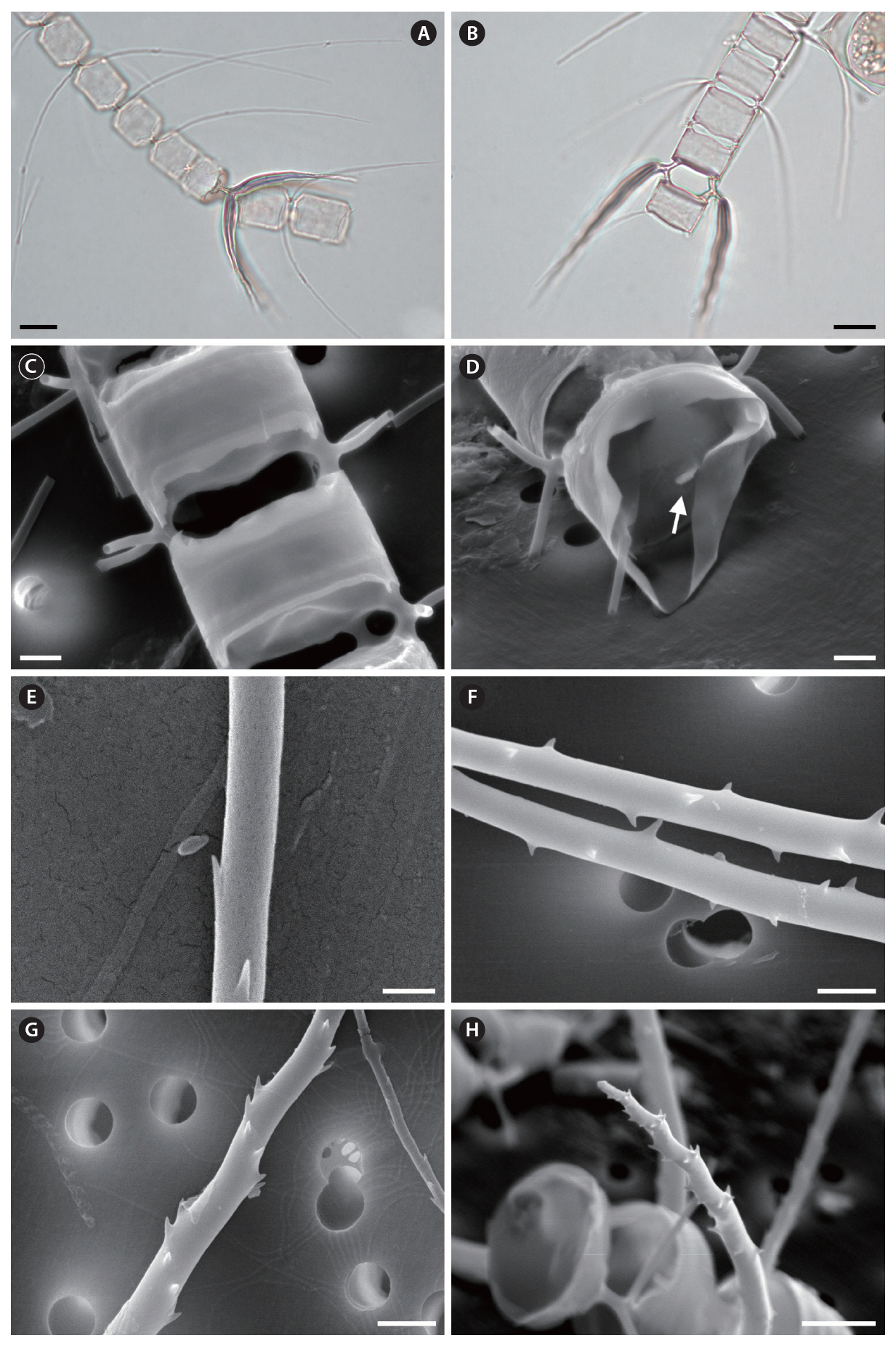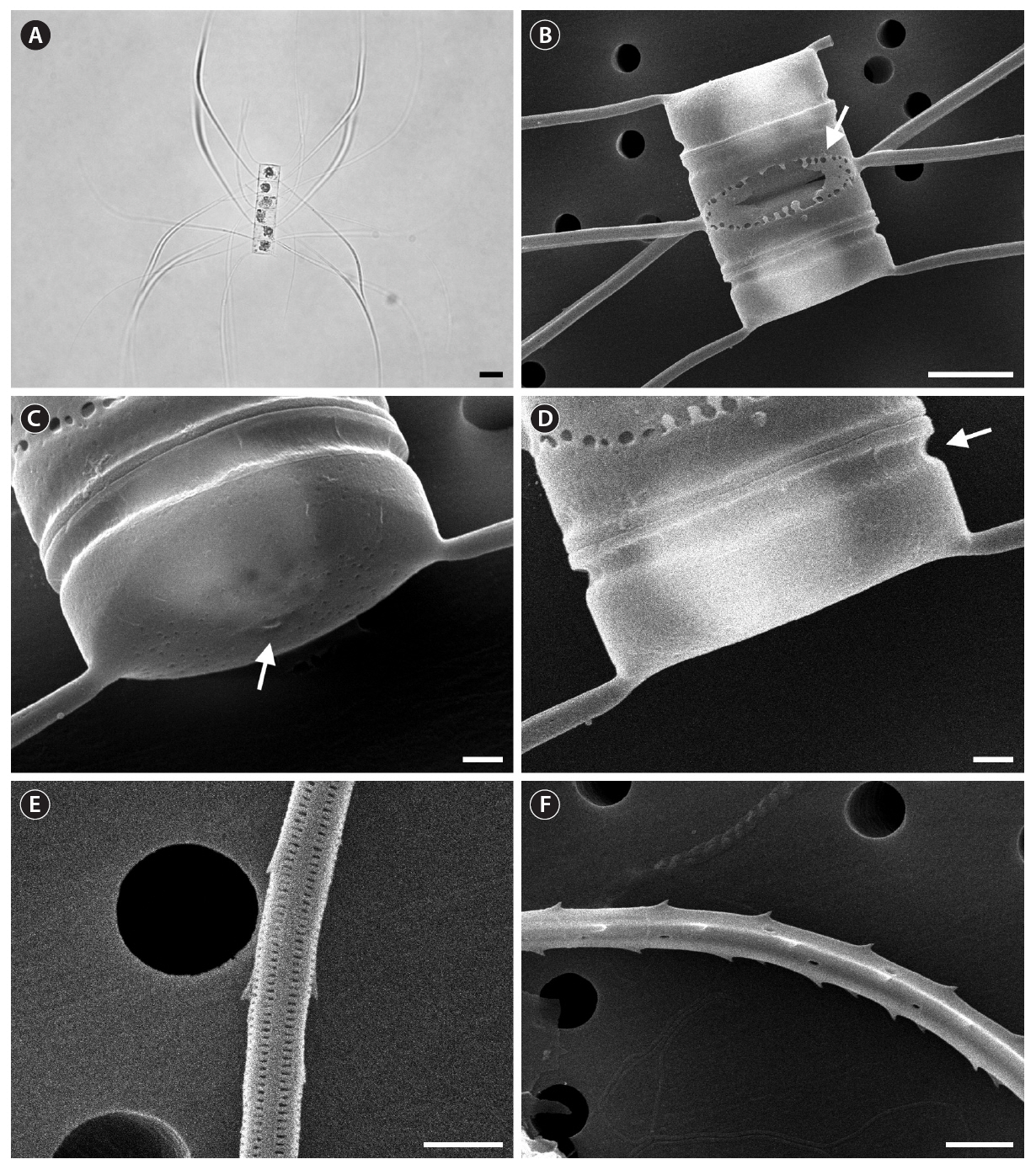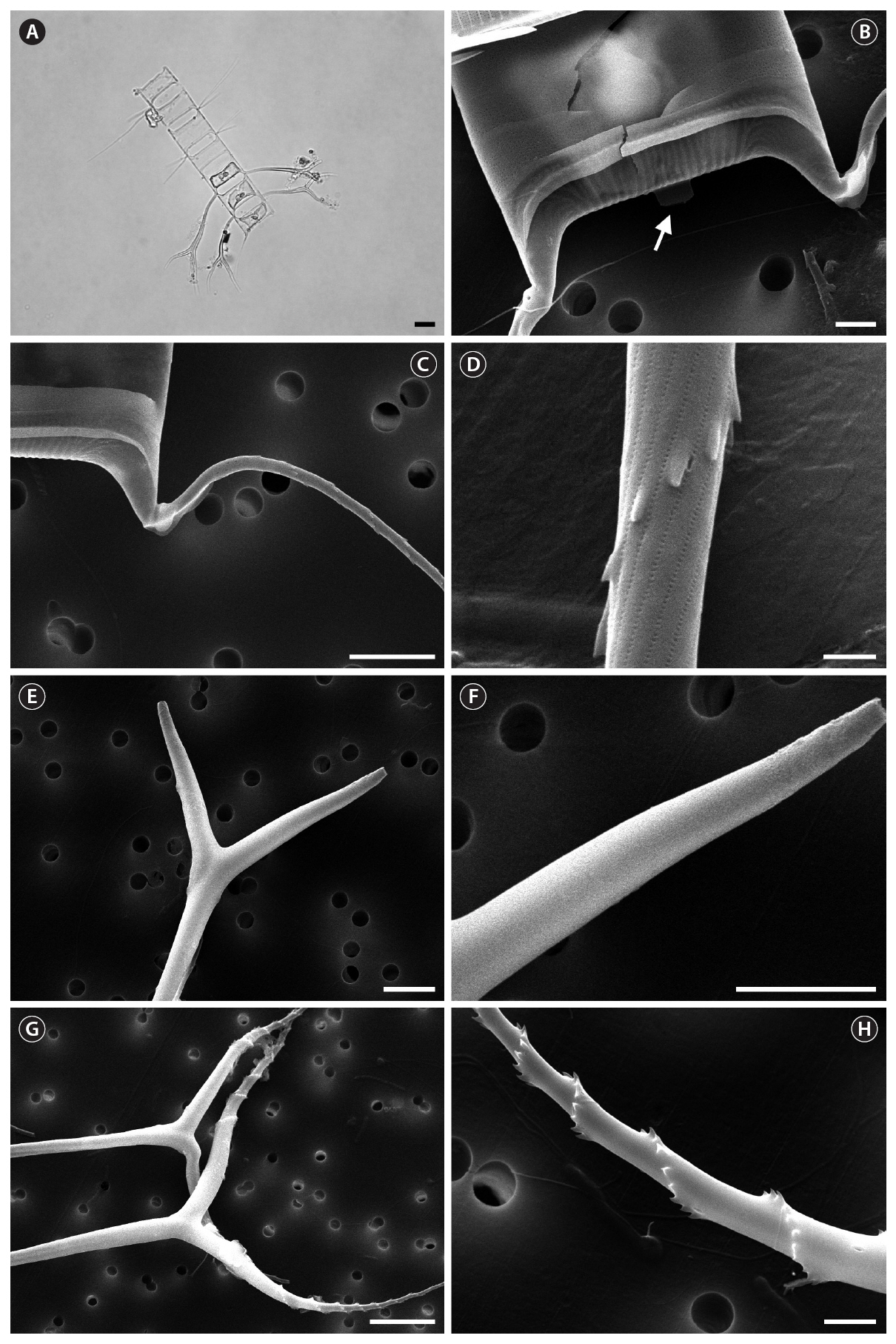



In 1844 Ehrenberg established the diatom genus
Sometimes, a few species have unusual intercalary setae,called “special intercalary setae” (Shevchenko et al. 2006). These are thicker and much more strongly silicified than are common intercalary setae (Cupp 1943, Hendey 1964, Shevchenko et al. 2006).
Records note nearly 80 taxa of
This study aimed to examine morphological differences of the ultra setae structures in the special intercalary setae of
From August 2008 to September 2009, we collected
For this study’s terminology, we adopted the general proposals made by the majority of authors (Cupp 1943, Brunel 1966, 1972, Anonymous 1975, Ross et al. 1979, Rines and Hargraves 1988, Hernandez-Becerril 1996).
>
Systematics of Chaetoceros Ehrenberg 1844
This study adopted Simonsen’s system (1979) based on phylogenetic ideas as follows.
Class Bacillariophyceae Haeckel 1878
Order Centrales Hustedt 1930
Suborder Biddulphiineae Simonsen 1979
Family Chaetoceraceae Smith 1872
Genus Chaetoceros Ehrenberg 1844
Subgenus Phaeoceros Gran 1897
Chaetoceros coarctatus Lauder 1864
Subgenus Hyalochaete Gran 1897
Chaetoceros compressus var. hirtisetus Rines et Hargraves 1990
Chaetoceros contortus Schutt 1895
Chaetoceros diversus Cleve 1873
Chaetoceros messanensis Castracane 1875
We examined 5
>
Chaetoceros coarctatus Lauder (
Lauder 1864, p. 79, Pl. 8, Fig. 8; Hustedt 1930, p. 655, Fig. 370; Cupp 1943, p. 107, Fig. 62; Hendey 1964, p. 121, Pl. 12, Fig. 1; Hernandez-Becerril 1991; Hasle and Syvertsen 1996, p. 200, Pl. 40.
Synonyms.
Cells form a straight, heteropolar, robust chain, usually long, having 12-16 cells. Chloroplasts appear numerous and have small, rounded bodies. Frustules appear cylindrical and elliptical in valve view, with an apical axis of 25-35 ㎛ and a transapical axis of 13-20 ㎛. Each valve Pehas an elliptical shape, flat face, and numerous small rimoportula. The valve mantle is usually high, often but a little higher than the girdle is. Foramina are absent or very small. Posterior terminal setae appear quite thick, large, smoothly curved, and heavily spiny, and they are shorter than the others setae. Common intercalary setae are straight or smoothly curved. The setae cross section diameter is 2.4 to 8.5 ㎛. Spines on the setae have a robust,long shape and appear in straight lines. One edge of a seta has 2-4 spines per 10 ㎛. Setae poroids possess small pores and a straight line arrangement, with one side having 63-104 poroids per 1 ㎛. The special intercalary setae curve strongly near their tips. Spines on these setae are more strongly siliceous than are spines of common intercalary setae. All intercalary setae are about 45° from the apical axis, toward the posterior end. They originate and fuse inside the chain edge, with 4 sides. These setae are coarse and thick arising from the valve margin.
Distribution. Reports place
Taxonomic remarks.
[Table 1.] Specimen collection data for this study
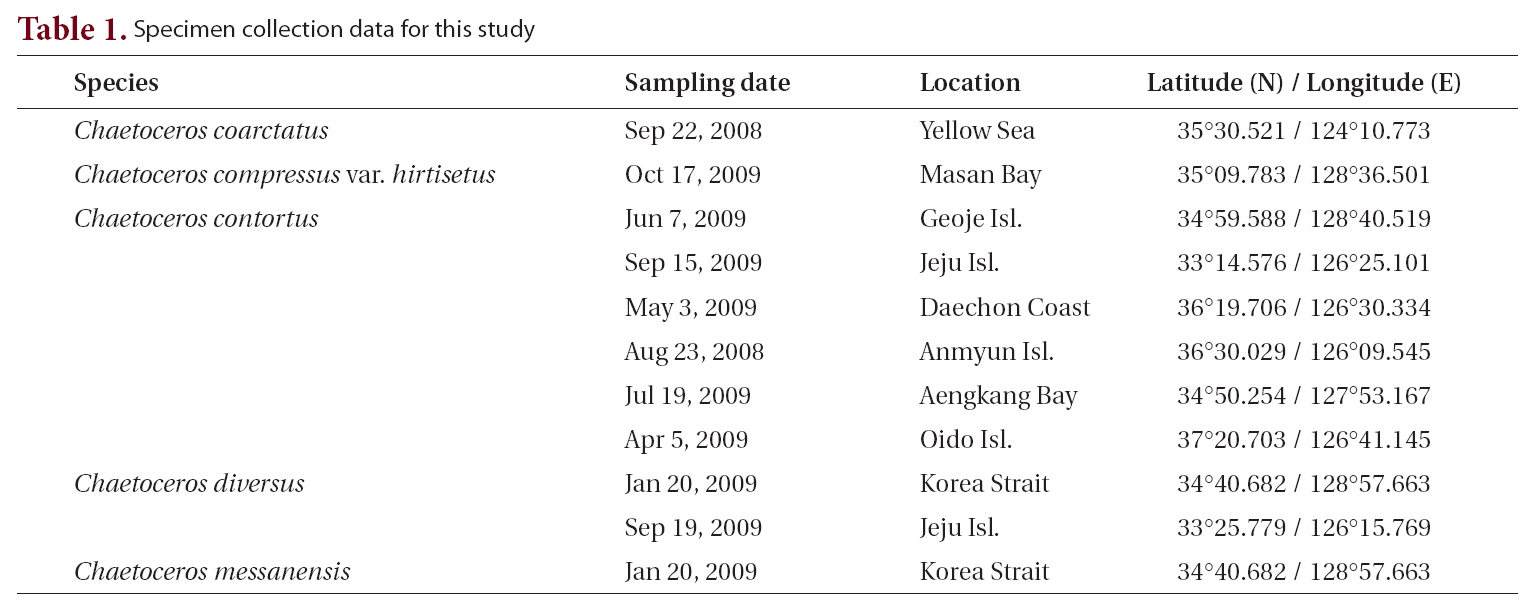
Specimen collection data for this study
The anterior terminal setae appear less robust than posterior setae do, and they curve toward the posterior end, with common and special intercalary setae possessing longer and stronger spines than those found in other species.
>
Chaetoceros compressus var. hirtisetus Rines and Hargraves (
Rines and Hargraves 1990, p. 114, Fig. 1-29; Shevchenko et al. 2006, p. 242, Fig. 35-39; Sunesen et al. 2008, p. 310, Fig. 5A-F.
Synonym.
These cells’ straight chains usually twist to the pervalvar axis. Frustules appear rectangular to quadrangular in girdle view. The apical axis is 7-9 ㎛. Valve face is centrally inflated and more or less flat. Foramina appear relatively wide and slightly constricted centrally. Usually,foramina near the special intercalary setae are wider than are those near the common intercalary setae. Valve mantle is shallow. Terminal setae appear thin and delicate and align almost parallel to the chain axis. Common intercalary setae are thin and delicate, with small spines and siliceous capilli at the proximal part, and are directed nearly perpendicularly to the chain axis. These setae originate and fuse inside the chain edge. Special intercalary setae have relatively long, thick, coarse, tapering ends, smoothly curved with large, spiral twisted spines, but do not possess siliceous capilli.
Distribution. Rines and Hargraves (1990) examined
[Table 2.] Common morphological characteristics of five Chaetoceros species
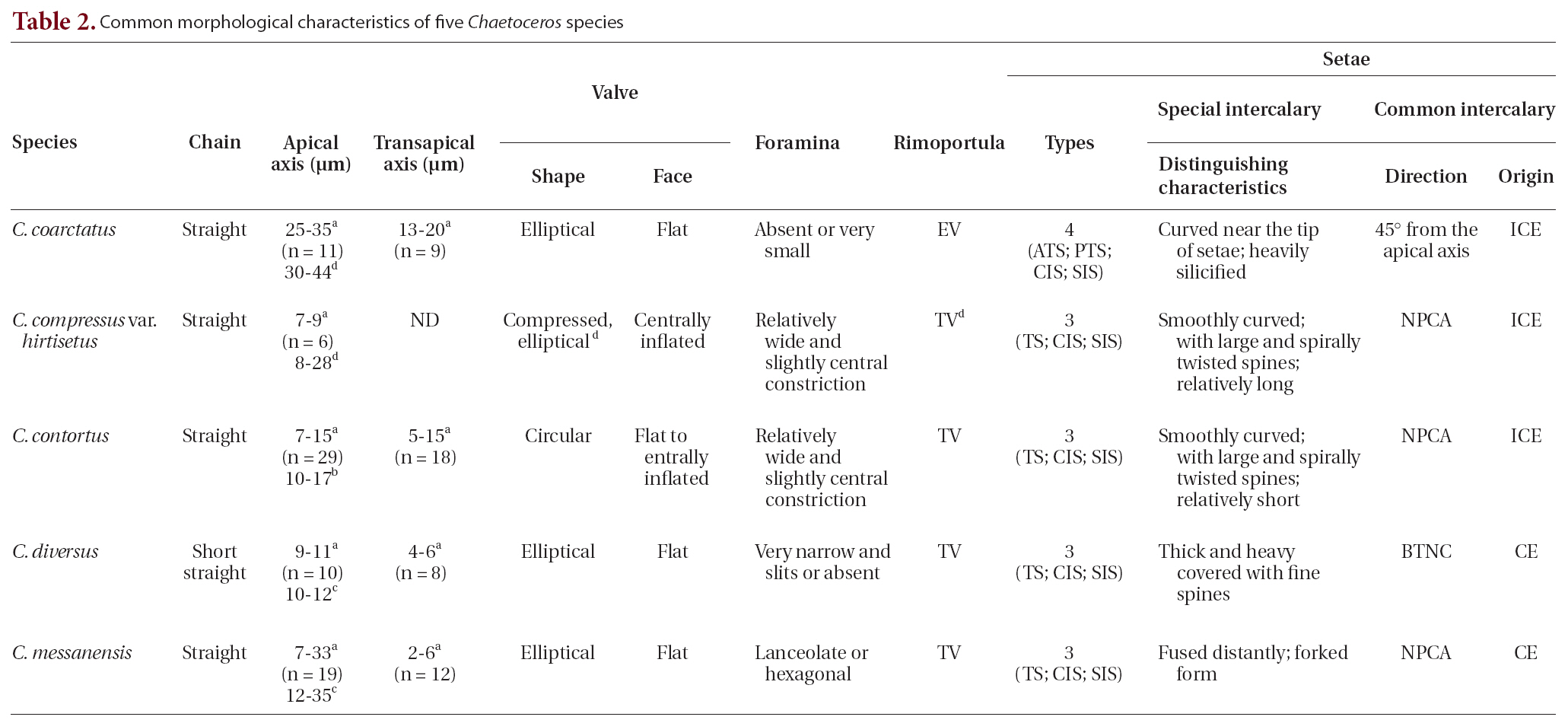
Common morphological characteristics of five Chaetoceros species
ter the Great Bay, Sea of Japan (Shevchenko et al. 2006). Sunesen et al. (2008) found the species in summer, fall, and spring off the coast of Buenos Aires Province. We found
Taxonomic remarks. The most distinctive features of
>
Chaetoceros contortus Schutt (
Schutt 1895, p. 44; Rines 1999, p. 541, Figs 7-43; Sunesen et al. 2008, p. 310, Fig. 5G-M; Shevchenko and Orlova 2010, p. 246-247, Figs 2 & 3.
Cells form long, straight chains that twist slightly about the chain axis. Chloroplasts comprise several small bodies. Frustules appear rectangular, with rounded corners, in girdle view. Apical axis is 7-15 ㎛, and transapical axis is 5-15 ㎛. The valve shape is broadly elliptical to circular, with a flat to centrally-inflated surface. Foramina appear relatively wide and have slight central constriction. Usually, foramina near the special intercalary setae are wider than are those of the common intercalary setae. Rimoportula occur on the terminal valve face. Terminal setae appear thinner and shorter than do common intercalary setae, which are thin and delicate, having small spines almost perpendicular to the chain axis. These setae originate and fuse inside the chain edge. Spines on the setae have a fine or robust shape and align in a helicoid arrangement, with 1 row of 5 to 6 spines per 10 ㎛. Setae walls are thin. Special intercalary setae appear relatively short, thick, coarse, and smoothly curved, with a tapering end having large, spiral-twisted spines in the direction of the chain axis. These setae possess 1 row of 6-11 spines per 10 ㎛. Setae poroids are invisible. The setae’s wall is thick. The common intercalary setae’s diameter is 0.4 to 1.3 ㎛ in cross-section.
Distribution.
Taxonomic remarks. Schutt first described and recorded this species in 1895, in the Baltic Sea. Gran (1897) pointed out that Schutt simply gave new names to different-sized specimens of the same species, which Gran and Yendo (1914) synonymized under the name
>
Chaetoceros diversus Cleve (
Cleve 1873, p. 9, Fig. 12; Hustedt 1930, p. 716, Fig. 4099; Cupp 1943, p. 132, Fig. 87; Hendey 1964, p. 130, Pl. 17, Fig. 4; Moreno Ruiz et al. 1993, p. 422-424, Fig. 2-28; Shevchenko et al. 2006, p. 248. Fig. 71-73.
Synonym.
Cells usually form a short straight chain. Each cell contains 1 chloroplast on the girdle side. Frustules appear rectangular in broad girdle view. Apical axis is 9-11 ㎛, and transapical axis is 4-6 ㎛. The valve has an elliptical shape and a face that is flat or slightly raised in the center.The valve mantle is high, and the girdle band is small. Foramina appear very narrow and lack slits. Rimoportula occur on the terminal valve. Terminal setae are always thin and differ in position from intercalary setae. Common intercalary setae appear thin and hair-like, slightly curved or, often, straight, and usually slightly turned toward the chain ends. Cross section shows the setae to be circular, 0.5 to 1.5 ㎛ in diameter. Setae spines posses a
fine shape and straight-line arrangement, with 1 row of 6-12 spines per 10 ㎛. Poroids of the setae have small slits and a straight alignment, with 1 row of 16-26 poroids per 1 ㎛. Special intercalary setae appear thick, heavy, and, frequently, covered with fine spines. The setae are clearly angular in cross-section, with spirally-arranged little spines. All intercalary setae bent toward the nearest end of the chain. They originate and fuse at the chain edge, arising at the valve corners without basal parts and running almost parallel to the chain axis in the outer part.
Distribution.
Taxonomic remarks. Leuduger-Fortmorel (1892) placed
>
Chaetoceros messanensis Castracane (
Castracane 1875, p. 394, Pl. 1, Fig. 1a; Hustedt 1930, p. 718, Fig. 410; Cupp 1943, p. 133, Fig. 89A & B; Hendey 1964, p. 129, Pl. 22, Fig. 3; Hasle and Syvertsen 1996, p. 216, Pl. 45; Shevchenko et al. 2006, p. 250, Fig. 90-92.
Synonym.
Cells form straight chains and have 1 chloroplast, near the girdle. Frustules appear rectangular with conspicuous corners beside adjacent cells in broad girdle view. Apical axis is 7-33 ㎛, and transapical axis is 2-6 ㎛. The valve is narrow and elliptical. Valve faces are flat, and valve mantles are low. Foramina are lanceolate or hexagonal.Rimoportula occur on the terminal valve. Girdle is usually deep. Terminal setae usually are thin and short, turning in different directions. Common intercalary setae are thin and short, arising as a thick pair through the fusion of contiguous cells’ setae. The setae have thicker basal parts, becoming more slender toward the ends. Node-like spines occur in spirals. The setae’s direction is nearly perpendicular to the chain axis. Setae spines are quite fine and helically arranged, with 1 row of 10-12 spines per 10 ㎛. Setae poroids have small pores and align in a helicoid arrangement, with 16-18 per 1 ㎛ in 1 row. Special intercalary setae are thick, long, and strongly silicified. These setae fuse a long distance and then diverge,unlike other setae. All setae originate and fuse at the chain edge.
Distribution.
Taxonomic remarks. Usually, the special intercalary setae of this species occur 1 or 2 to a chain. We observed forked special intercalary setae, which have two forms. The first type has rows of spines in spirals (Fig. 4G & H), while the second type has no spines (Fig. 4E & F). The forked special intercalary setae are this species’ most conspicuous characteristics. We found all of the types in the Korea Strait in this study.




